Critiquing the Collection: Pride Month feature
Critique the Collection invites community members to engage with The Art Gallery of Windsor by choosing a work from the Gallery’s permanent collection, examining it through a critical lens, and submitting a creative critique in their preferred artistic discipline.
For Pride month, we want to appreciate the many 2SLGBTQ+ folks and allies who have worked, and continue to work, to create a world of acceptance, celebration, and joy for the 2SLGBTQ+ community. We are grateful to have artists from the 2SLGBTQ+ community in our collection, telling stories and sharing ideas that are important to all of us.
In our program Critique the Collection, Volume 2, some of our critics chose works from the collection that were created by 2SLGBTQ+ artists, and provided added context to artworks that continue to be relevant. Today, we’re highlighting one such critique by Janet MacIsaac, who critiqued David Buchan’s piece Canadian Youth (from Cold City Gallery Portfolio) (1989). Read Janet’s critique below!
“David Buchan’s (1989) Canadian Youth is a near faithful photographic (re)production of the Charles H. Scott (1937) painting of the same name. David uses his source images as a “point of departure.” (1) He does this through staging the scene in his works, playing with the meaning of the image to draw our attention to the constructed ‘reality’ of mass media.(2) Although a departure from his earlier process of inserting himself as the subject into his (re)productions, Canadian Youth heightens our awareness to the fabricated reality of advertising media. (3,4) David reminds us that mass media culture is always trying to sell us something that we lack but which is not ‘real’. The saturated colour profile in Canadian Youth gives us a general idea that the ‘reality’ presented is not what it seems.
David plays with the original details in the image meant to portray a ‘happenchance’ nature scene in British Colombia. Sand becomes a tan tarp. The people are props. The idyllic forest backdrop becomes a print from a wallpaper store. A wine bottle is inserted, labelled ‘Super, Natural’ referencing the BC’s Ministry of Tourism slogan.(5) These pieces come together to draw our attention to the image’s staged ‘nature.’ Nothing here is real. As a queer non-binary woman, I was initially drawn to a narrative of queer desire that I found in the image. However, upon further engagement with David’s work, I see this image reaching across time to remind us of the modern day commodification of queer and trans identity (i.e., rainbow capitalism). Canadian Youth stresses that our representation in mass media is being done to sell something back to us.”
Janet MacIsaac is a white, queer, non-binary woman living in so-called Windsor while she completes her PhD in Applied Social Psychology. Janet’s research focuses on trans embodiment and materializing gender euphoria through visual methods, particularly photography. When not working on their degree, Janet can usually be found biking in the county.
Sources
1 Stacey, Robert. (1993). Conspicuous Consumption. In L. Dompierre, David Buchan: Inside the Image (pp. 27–30). The Power Plant.
2 Maher, Sabrina. (2014). An Introduction to the language of partial seduction: Works by David Buchan [Unpublished master’s thesis]. University of Toronto.
3 This shift appears to be related to a decline in his health from HIV/AIDs, which he contracted near the end of the 1980s, see Maher (2014).
4 Chitty, Elizabeth. (1996). David Buchan: Man-about-town. Coach House Printing.
5 This is an interesting reference as at the time the government was dealing with issues of clear-cutting old growth forests (see Stacey, 1993). Apparently, the advertisements were handled by an agency that staged the tourism commercials, thus the ‘super, natural’ BC is a fabricated reality. The placement of the wine bottle in the image with this message acts to further reinforce the fabricated reality of what we are viewing and that we are being sold something in this image.
